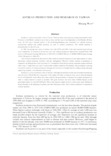Soybean is a crop of economic value in Taiwan. There are three crops each year, spring crop planted in mid February to mid-March; summer crop in June to July; and fall crop in late September to mid-O ctober. Of these crops, the fall crop is planted mainly in the Kaohsiung-Pingtung area. Generally two cultural practices, conventional method and stubble planting, are used in soybean production. The stubble planting is predominantly for the fall crop.
In 1982, the acreage and value of soybean were only 0.85% and 0.24% of the total national crop land and value, respectively. In contrast to the pre-war years, the soybean production significantly increased from 3,500 tons on 6,100 hectares (average 600 kg/ha) in 1936-1945 to 63,000-67,000 tons on 40,000-50,000 hectares (average 1,500-1,700 kg/ha) in 1964-1973.
This increase resulted from the extensive effort mady by research institutions in the improvement of variety, physiology, cultural practices, nutrition, and pest management. However, further increase in production is expected to be difficult due to the constraints in I ) competition from the low-priced, imported soybean and from other crops; 2) high labor cost; and 3 ) unfavorable weather conditions. Nevertheless, the government is striving toward the increase of soybean production through the conversion of paddy land for soybean along with price supporting program, cost reduction and research.
Soybean is a crop of economic value in Taiwan. Although the production had once increased tremendously since the end of World War II, a large part of the supply still relies on imports every year to meet the demand for oil and feedstuffs. Great efforts have been made by the government to increase the soybean production in order to reduce imports as much as possible. This goal, however, has never been fulfilled because of the government policy for rice self-sufficiency. Due to the excessive supply of rice in recent years, more farmland is being allocated to the planting of soybean and other feed grain crops. Thus soybean production is expected to increase hereafter.

